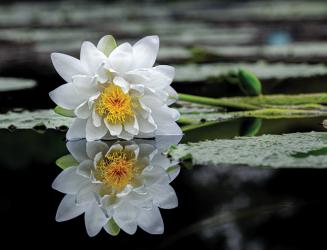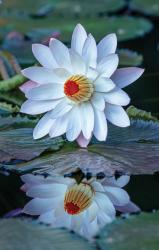Victoria amazonica water lilies can grow up to 10-feet across, making them a fan-favorite at the Garden for more than a century. In 1894, more than 30,000 people gathered at the Missouri Botanical Garden to see the bloom of its first Victoria Water lily flower. In 2018, thanks to a generous donation from Michael and Jeannie Gleason, the center pool of the Garden’s Central Axis got a new heating system. This has extended the season for Victorias to grow in the outside pools and allows them to grow even larger than they had in summers past.
Barely the size of a penny, the Nymphaea thermarum has small white flowers, less than a half an inch across, and the entire plant may only reach 7 to 8 inches. The little lilies are incredibly rare. The plant was discovered in 1987, and less than 30 years later it was considered extinct in the wild. The Missouri Botanical Garden received seed of Nymphaea thermarum in 2017 from Arnold Arboretum at Harvard University.
Where to see water lilies at the Garden: Water lilies are on display from May-October in the pools in front of the Linnean House, the Central Axis, and in the George Washington Carver Garden. Victorias can be found in the middle pool in the Central Axis. N. thermarum can be found in the Climatron.
Water lilies are on display from May–October in the pools in front of the Linnean House, the Central Axis and in the George Washington Carver Garden. Victorias can be found in the middle pool in the Central Axis. Nymphaea thermarum can be found in the Climatron.







